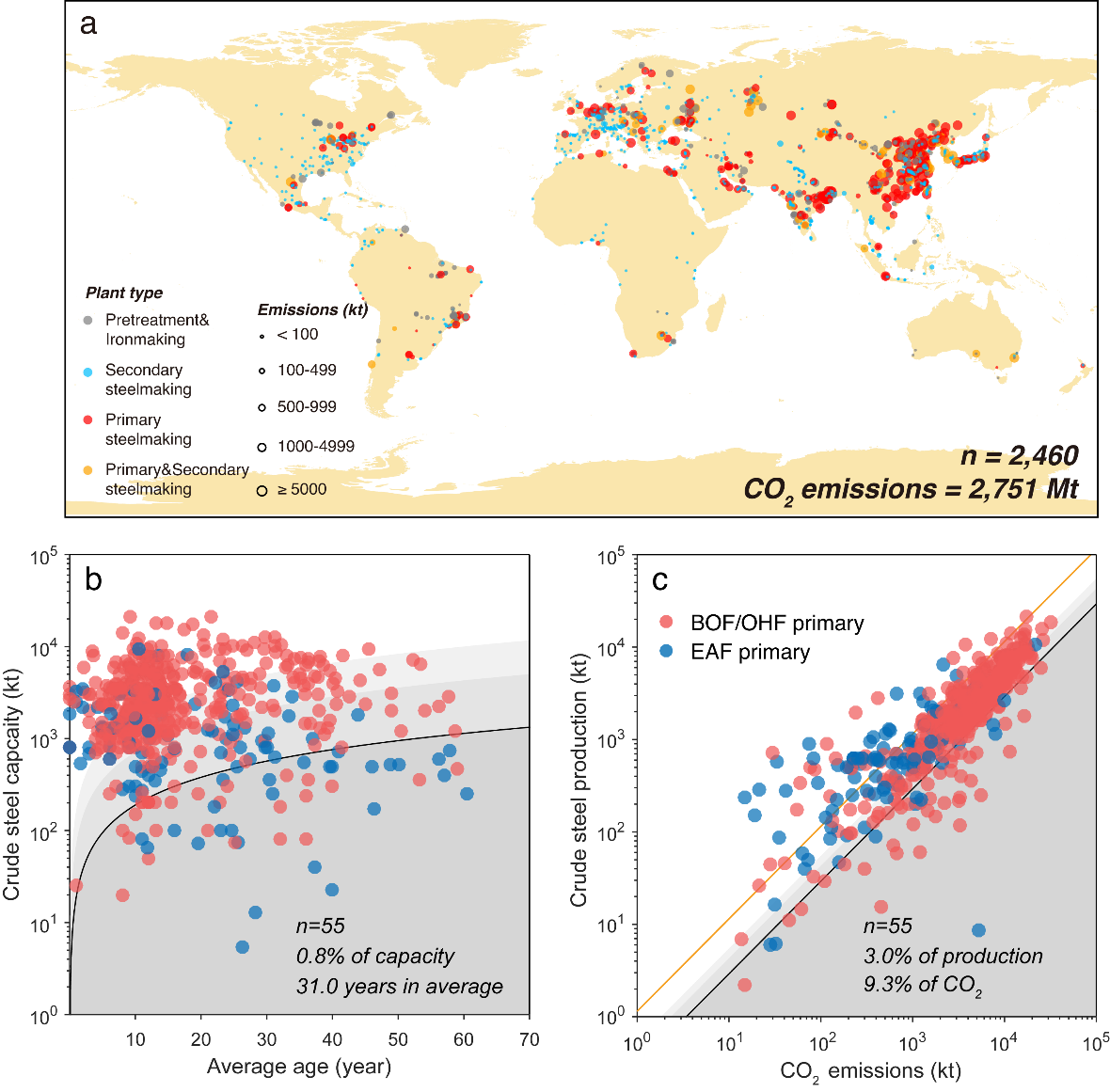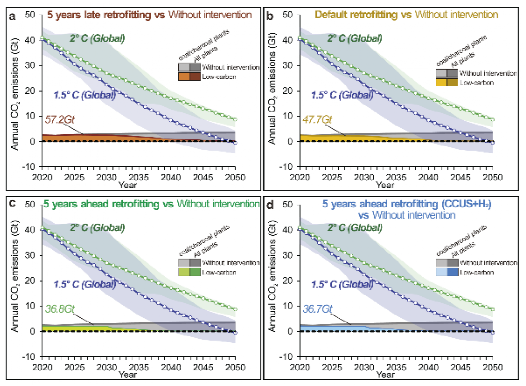The iron and steel industry, with carbon dioxide emissions contributing about 25% of the total industrial emissions in the world, is the industry with the highest carbon emissions in the global industrial sector. Urbanization and industrialization in the recent decades have led to a sharp increase in steel demand, which has in turn promoted the construction of a large number of steel production facilities around the world, posing great challenges on the global steel industry for emission reduction. At present, the emissions from the steel industry mainly come from the complicated long-flow steelmaking process involving multiple emission links, with immature emission reduction technologies. Therefore, the iron and steel industry is recognized as one of the most challenging sectors to reduce emissions, and its emission characteristics and emission reduction pathways are frontier problems drawing close attention from the field of carbon neutrality research.
To address this important frontier problem, the research groups of Professor Guan Dabo, Assistant Professor Tong Dan and Professor Zhang Qiang of the Department of Earth System Science (DESS), Tsinghua University have carried out cooperative research, supported by the project “Atmospheric Composition Change and Climate Environmental Impact” of an innovative research cluster of the National Natural Science Foundation of China. Based on the self-developed Global Iron and Steel Emission Database (GISD), they have analyzed the carbon emission characteristics of the global steel industry in detail, constructed a plant-by-plant decarbonization strategy for the global steel industry, and put forward highly differentiated carbon neutral pathways for the global steel industry. The related achievements have been published online in the form of companion papers titled “Global iron and steel plant CO2 emissions and carbon neutrality pathways” and “Plant-by-plant decarbonization strategies for global steel industry” in Nature and Nature Climate Change on September 20.
In this study, the team first collected and arranged the basic information at the facility level in the global steel industry, including coking, sintering, pelletizing, iron smelting and steelmaking. On this basis, a dynamic emission characterization algorithm was constructed and a global steel industry carbon emission database independently developed covering more than 10,000 facilities, upgrading the global steel emission characterization ability from regional and industry scales to the scale of a single facility and process (Fig. 1). On this basis, drastic differences have been identified in the scale, technology, age and carbon emissions of steel industry facilities in different countries across the world. For example, in China, coal-based blast furnace-basic oxygen furnace plants (Coal BF-BOF) are dominant, with an average carbon emission intensity being about 1.6 (t CO2/t crude steel, the same below), lower than the global average (1.7); while the iron and steel industry in India is dominated by Coal BF-BOF coal-based direct reduction iron (DRI) plants, with average carbon emission intensities of 2.3 and 2.7 respectively.
It has been pointed out in the study that the energy consumption efficiency of steel plants often decreases with the increase of operating life, and 43% of the steel plants worldwide have been reformed by upgrading and installing devices to achieve the purpose of improving energy efficiency and prolonging operating life. The retrofitting time node is related to the technical level and aging degree of a facility, generally after the facility has been in service for 15-25 years (that is, in the retrofitting window period). From the perspective of production technique, the carbon dioxide emissions of the long process of the blast furnace-basic oxygen furnace (BF-BOF) contribute more than 70% of the total carbon emissions of the global steel industry, and therefore the low-carbon retrofitting of this process is the key to achieving carbon neutrality in the global steel industry.
Based on a detailed analysis of emission characteristics, two targeted indexes, namely, emissions intensity (defined as carbon emissions per unit crude steel output) and age-to-capacity ratio (defined as the ratio between average age and crude steel production capacity), have been designed to identify the decarbonization priority of long-process steel plants from the aspects of emissions reduction potential and economy. In view of the design of long-process steel plants, including excess capacity elimination, energy efficiency improvement and short-process retrofitting, the decarbonization potential and cost-effectiveness of each steel plant are carefully evaluated, revealing the plant-level decarbonization strategy that takes into account the "quantity" and "efficiency" of emissions reduction around the world and in key regions.
It has been found that the average energy consumption of steel plants in developing countries is higher, and the carbon emission intensity index can be used to determine the priority of decarbonization to achieve higher emission reduction potential, while the average age of steel plants in developed countries is longer, so it is more effective to use the age-to-capacity ratio index. In developing countries, the cost of energy efficiency improvement is close to that of short-process retrofitting, so energy efficiency improvement can be prioritized in the near future, and short-process retrofitting can be gradually promoted in the medium and long terms. However, the iron and steel plants in developed countries have a high level of energy efficiency, and the potential of energy efficiency improvement and emission reduction is small. The emission reduction cost of short-process retrofitting is significantly lower than that of energy efficiency improvement, so short-process retrofitting should be taken as the main decarbonization strategy. Because retirement of old plants does not entail stranded capital, on the basis of energy efficiency improvement and short-process retrofitting, further giving priority to retirement of excess capacity can significantly improve the cost-effectiveness of decarbonization. On the basis of the above analysis, the comprehensive age-to-capacity ratio and carbon emissions intensity have been studied, and the most cost-effective decarbonization strategy for the global steel industry is put forward.
It is pointed out in the research that promoting low-carbon and zero-carbon technologies as soon as possible is the key to achieving deep emission reduction in the global steel industry. If the global steel industry operates as it is now, its cumulative carbon dioxide emissions would hit 106.3 billion tons from 2020 to 2050. If the facilities are upgraded with low-carbon and zero-carbon technologies during the retrofitting window, the cumulative carbon emissions of the global steel industry would be reduced to 47.7 billion tons from 2020 to 2050. If the technology is upgraded five years before the retrofitting window of a facility, the cumulative carbon emission of the global steel industry would be further reduced to 36.8 billion tons from 2020 to 2050 (Fig. 2).
A facility-level carbon emission database of the global iron and steel industry is established innovatively in this study, and on this basis, the decarbonization strategy and the carbon neutral pathway of the global iron and steel industry are put forward. The research results show that the targeted governance of "one plant, one policy" is the key to realizing the low-carbon transformation of the global steel industry, which provides an important scientific basis for the next step to formulate the emissions reduction roadmap of the global steel industry. The high-resolution emission database of the steel industry established herein can provide data basis for carbon emission accounting, technical potential assessment of emission reduction, cost-benefit analysis of emission reduction and other related research work in the global steel industry.
Lei Tianyang and Xu Ruoxian, doctoral candidates from the DESS, Tsinghua University, are the first authors of the two papers respectively, and Professor Guan Dabo and Assistant Professor Tong Dan are the corresponding authors of the two papers respectively. The work was supported by an innovative research cluster project of the National Natural Science Foundation of China and the Energy Foundation.
Full-text links of the paper:
https://doi.org/10.1038/s41586-023-06486-7
https://www.nature.com/articles/s41558-023-01808-z
Written by Guan Dabo and Tong Dan
Edited by Wang Jiayin
Reviewed by Geng Ruin

Fig. 1: Direct CO2 emissions from iron and steel plants worldwide and disproportionalities of age-to-capacity ratio and emissions intensity of primary steelmaking plants in 2019.

Fig. 2 Cumulative CO2 emissions from iron and steel plants under different low-carbon scenarios from 2020 to 2050.